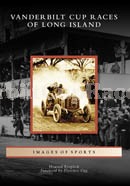Long Before NASCAR, Dirt-Road Daredevils: New York Times March 16, 2008

Long Before NASCAR, Dirt-Road Daredevils: New York Times March 16, 2008
By KARIN LIPSON
Published: March 16, 2008
HOWARD KROPLICK’s fascination for local history has led him into lots of musty library archives, looking for the Long Island that predated suburbia.
“I was especially interested in areas where I lived,” said Mr. Kroplick, 58, who grew up in East Meadow and now lives with his wife and two daughters in East Hills. “I loved looking at the pictures of before and after.”
In 2003, Mr. Kroplick chanced upon an old program from the Vanderbilt Cup Race, an automobile rally held on Long Island from 1904 to 1910. “Up to that point, I had never heard of it,” he said. Yet the races were celebrated sporting events of their day — “like Nascar and the Super Bowl” combined, Mr. Kroplick said — attracting more than 250,000 spectators at their height.
When Mr. Kroplick, the chief executive of a medical communications company in Manhattan, realized that the race route included Glen Cove Road, “a road I drive on every day,” his obsession, as he jokingly calls it, began. It led to “Vanderbilt Cup Races of Long Island,” published last month by Arcadia Publishing, which is filled with vintage photos of a time when cars still used roads created for horses and daredevil drivers risked life and limb — and not just their own — as they careened around in their unstable vehicles.
As the book indicates, races could tally up to nearly 300 miles, with cars speeding for 10 laps or more on roads jammed with onlookers. “It was such an early stage of the automobile, I don’t think a lot of spectators realized the danger they were in,” Mr. Kroplick said. Built for racing, many cars “had tires that were almost as thin as bicycle tires, the brakes weren’t great, the steering wasn’t great, and these guys were going at speeds of 60 to 90 miles per hour.”
Mr. Kroplick maintains a Web site, vanderbiltcupraces.com, about the rallies and their direct outgrowth, the now mostly defunct Long Island Motor Parkway. He has also lectured and organized exhibitions on the subject at museums, libraries and historical societies, many of which he once scoured for the 20,000 images he documented.
One key source of information was the Suffolk County Vanderbilt Museum in Centerport, the onetime estate of William K. Vanderbilt Jr., the railroad heir and sportsman who initiated the rallies. (The museum’s former director of collections and archives, Florence Ogg, wrote the foreword to Mr. Kroplick’s book.)
An avid racer in Europe, Willie K., as he was known, was distressed by the superiority of foreign autos. “He really wanted the American manufacturers to catch up with the European cars,” Mr. Kroplick said. So Vanderbilt commissioned a 30-pound silver loving cup from Tiffany’s, and in 1904 the Vanderbilt Cup Race became the first major international road race in the United States.
In 1908, an American-made car finally crossed the finish line first. But crowd-control issues and several fatalities led to cancellation of the events on Long Island after 1910. In all, there were six Vanderbilt Cup races on the Island.
How well did they fulfill Willie K.’s dream of a better car?
“It’s difficult to quantify,” Mr. Kroplick said. “I think it had an influence, because this was the one place where everybody interested in automobiles got together, met, and compared notes.”
Just as significantly, the races whetted the interest of average Americans in owning a car. “It showed what cars can do,” Mr. Kroplick said. “This was the first exposure to automobiles of the common man.”

Comments
i just read my ny times and saw the article on the vanderbilt cup races. i have lived a few blocks from the vanderbilt motor parkway for 26 years and have always been interested in the history of the race as well historic automobiles and the colorful characters that have shaped the early history of the automobile. the article and your website has provided me with a great deal of wonderful information that was previously unobtainable to the average person.for instance, i did not know that louis chevrolet drove in the race 4 times, but did you know that the last automotive job he held was as an assembly line worker for chevrolet…...go figure…but thats a story for another time…..again many thanks for all the wonderful information..kevin
Kevin, thanks for the feedback on the website.
Louis Chevrolet always drove hard in his four Vanderbilt Cup Races (1905, 1908, 1909,and 1910). In the 1910 Vanderbilt Cup Race (22 laps over a 12.64 mile course), Chevrolet led the the race after 7 laps averaging 72 mph. He lost the lead and then regained it during lap 14. However, his Marquette-Buick broke a steering knuckle on lap #16 and crashed into a spectator’s car. The resulting death of his mechanician Charles Miller helped put an end to the Vanderbilt Cup Races on Long Island.
Griffith Borgeson’s book “Golden Age of the American Racing Car” provides an excellent chapter on Louis Chevrolet:
http://books.google.com/books?id=MDMFSp7xTp0C&pg=PA61&dq=Louis+Chevrolet&sig=9LuehLOZuDDSC2oM3IYrDIubc2Q